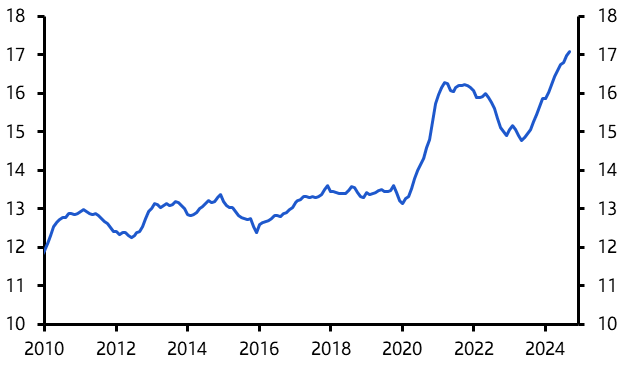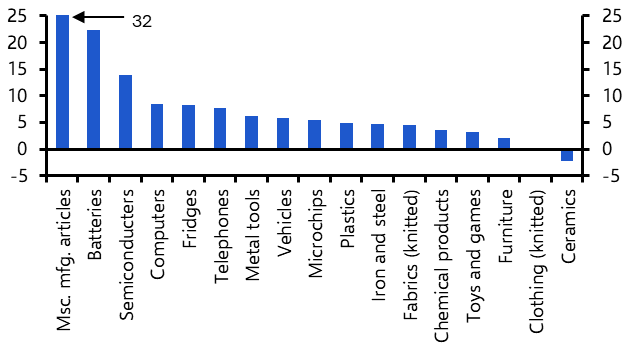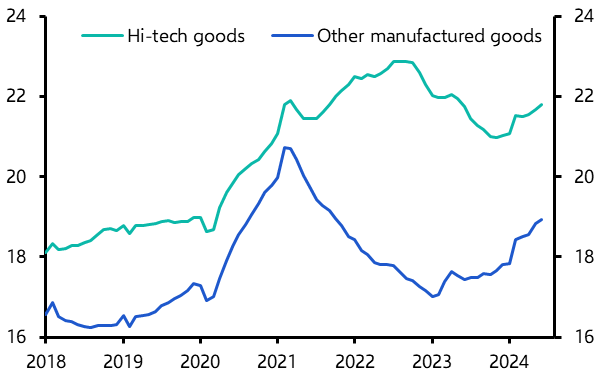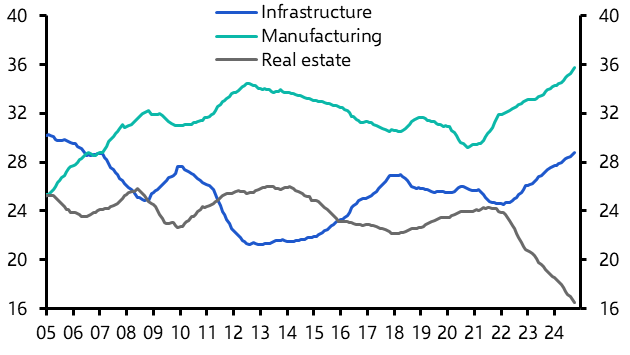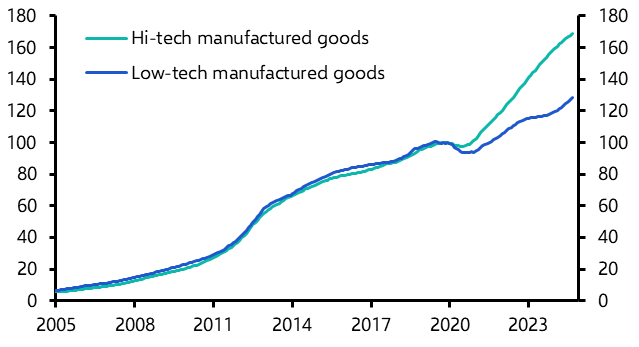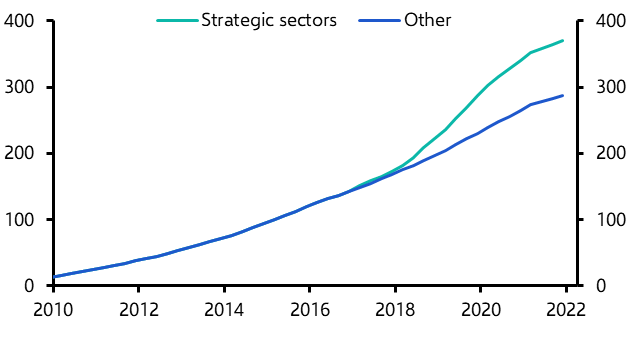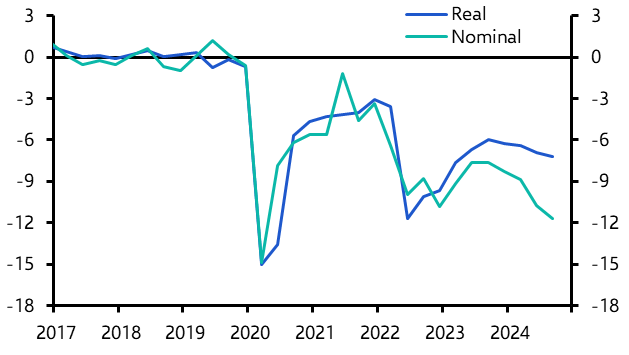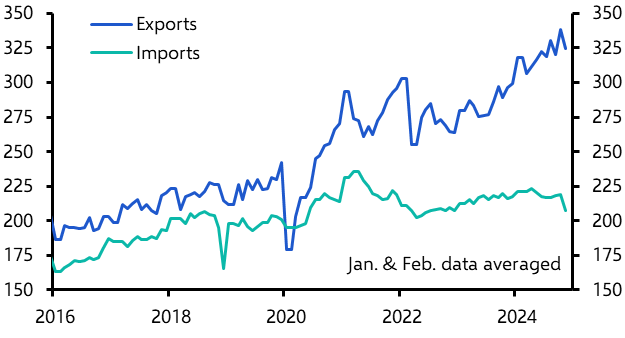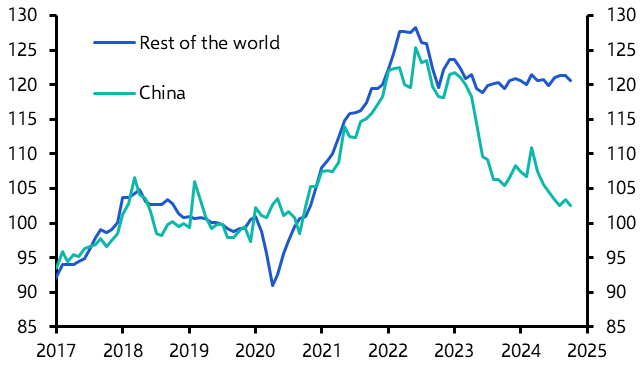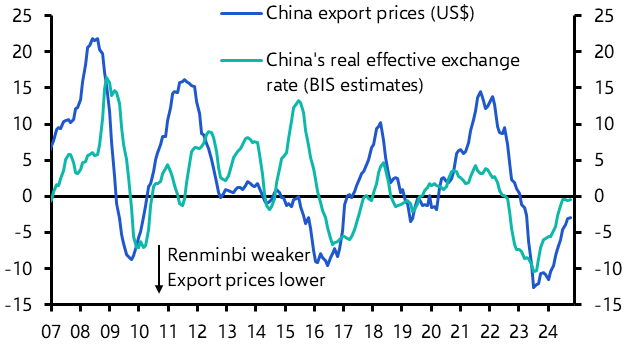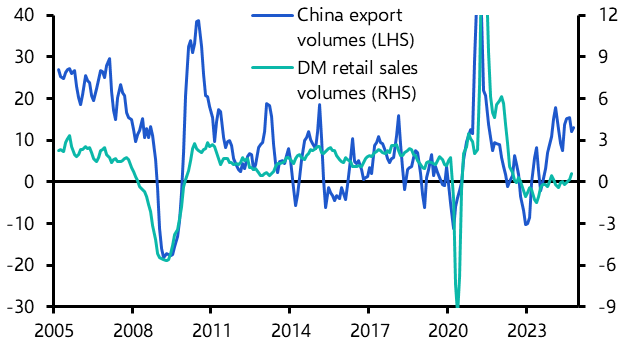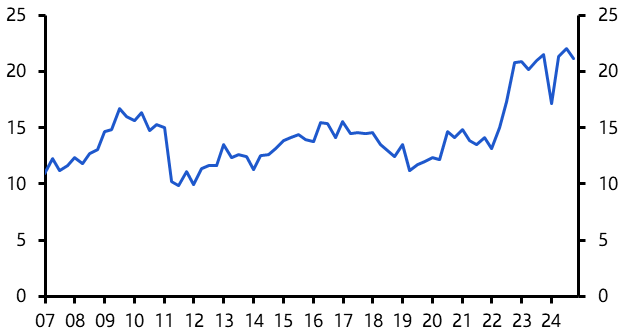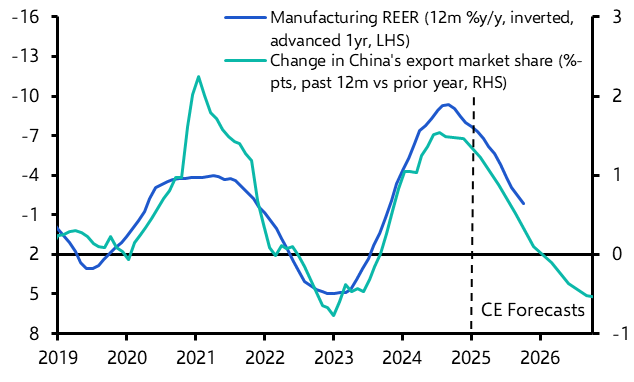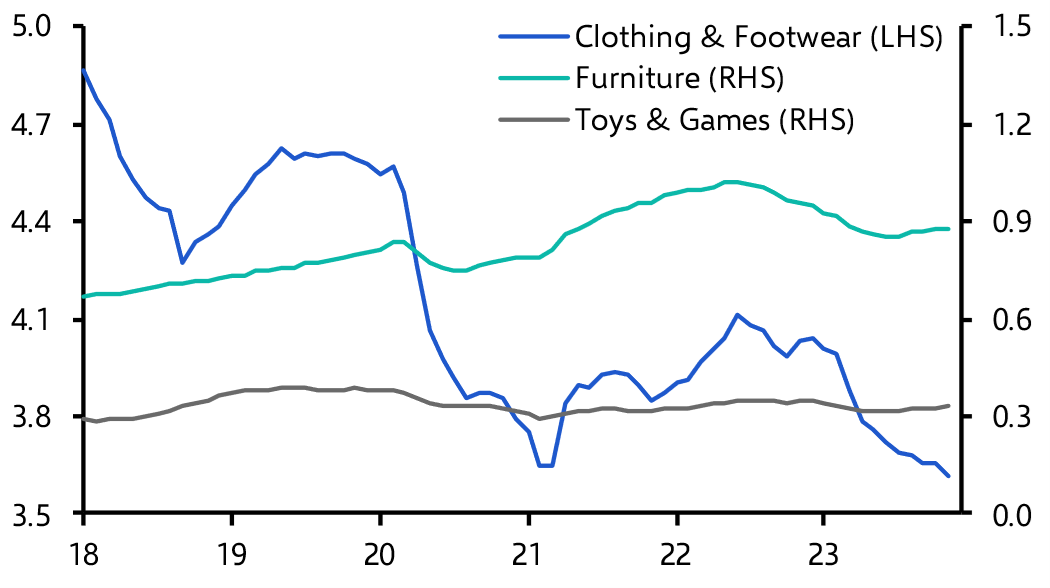- China’s surging exports have been gaining international attention, but concerns about overcapacity have focussed on “strategic sectors”. Far less acknowledged is the fact that China has been gaining significant global export market share across the board, including in labour-intensive, lower-end industries that have historically been dominated by economies at earlier stages of their development. These broad-based gains are largely the result of industrial policy and a growing imbalance in China between domestic supply and demand across industries. Trump tariffs will result in a small drop in China’s export share. However, we think China will hold onto most of its export gains, with the country's market share stabilising over the medium-term.
- China’s global export market share has risen rapidly over the past couple of years. That hasn’t gone unnoticed – international scrutiny has been ramping up, with countries including the US and EU imposing tariffs on imports from China. So far, attention has largely been confined to China’s gains in strategic sectors like EVs and semiconductors.
- However, a closer look at the data shows that the majority of Chinese goods have gained global market share in recent years. This includes lower-end, labour-intensive manufactures like textiles and toys. These industries have historically been dominated by lower-income EMs at earlier stages of industrialisation and haven’t been the focus of China’s industrial policy. Given China’s development and its successes in expanding high-end exports, its market share in low-end goods might be expected to be falling.
- Three factors explain why China has gained market share across such a broad range of sectors. First, while industrial policy has largely targeted hi-tech industry, investment in lower-end manufacturing has also been growing faster than its pre-pandemic pace. Automation has helped boost productivity in historically labour-intensive industries. And the effects of manufacturing subsidies on downstream industries have meant that sectors that haven’t been the target of industrial policy have also seen benefits. This has resulted in a rapid increase in manufacturing capacity across most industries.
- Second, growth in Chinese consumer demand has slowed as income growth has weakened and falling property prices have eroded household wealth. This imbalance has led to a surge in excess manufacturing capacity relative to domestic demand.
- Finally, to prevent this excess capacity from going unused, manufacturers have slashed prices, making Chinese goods more competitive in the global market. That’s caused Chinese exports to surge across the board, despite relatively sluggish global demand.
- We don’t think that any of the factors that have driven these export gains are set to unwind. Fiscal support will only provide a small and temporary boost to domestic demand. And investment will remain strong, leading to a further expansion in industrial capacity. As a result, China’s export market share is set to remain elevated over the medium-term.
- This means that China’s manufacturing sector will continue to present a serious competitive threat to both DMs and EMs alike. Cheap Chinese green-tech may hold back green-tech manufacturing in DMs. And by outcompeting EMs in labour-intensive industries that have typically been an avenue for rapid catch-up growth, China’s manufacturing strength may slow the development of lower-income economies.
- However, President Trump’s return to office means that US tariffs on Chinese goods could escalate soon. That will erode some of the competitiveness of Chinese goods in the US market – the fall in exports to the US will result in a small hit to China’s global export market share. However, unless other countries impose sweeping tariffs too, we think China will hold on to most of its gains, with the country’s export market share stabilising over the medium-term.
Rising export share
The pandemic-induced surge in global goods demand saw China’s share of world exports rise rapidly in 2020. The country’s export share levelled off after a year and started to drop back in 2022. However, over the past two years, China’s global export market share has soared again to record highs. (See Chart 1.)
|
Chart 1: China Goods Export Volumes |
|
|
|
Sources: CEIC, CPB, Capital Economics |
This hasn’t gone unnoticed. International scrutiny of China’s overcapacity has been ramping up, particularly over “strategic” goods that have been the subject of industrial policy in China. In May 2024, the Biden administration levied new tariffs on China’s exports of “strategic” goods including lithium-ion batteries, solar cells, EVs and semiconductors. An EU probe into China’s export “dumping” resulted in new tariffs being implemented on electric vehicles from China in October. But while the bulk of international attention has focussed on strategic sectors, that’s only part of the story. There have also been extraordinary gains in China’s market share in other areas.
Beyond strategic goods
To shine a light on what’s been driving China’s export growth, we’ve broken down China’s goods exports by HS2 commodity classification (and HS4 for some larger sub-groups). At the aggregate level, the breakdown paints a clear and surprising picture. China’s global market share has expanded for almost all goods since 2019. The few for which China’s share hasn’t risen have seen little change. In only a handful of sectors has China’s market share materially declined – these include furskins, cotton and straw goods. (See Chart 2.)
We’ve used Harvard’s Product Complexity Index to rank goods in Chart 2 on a gradient according to their manufacturing complexity (pink for lower and blue for higher in the interactive version of the chart). While it’s true that most of the products that have lost market share are lower-tech, the majority of less complex products have gained market share since 2019. This includes goods like toys, furniture and some textiles. The labour-intensity of these goods means their production has historically been dominated by low-income EMs where labour costs are low. China’s labour costs have been rising as the country has developed and modernised – its growing market share in labour-intensive goods breaks the mould.
The strategic industries identified by the State Council in the Made in China 2025 plan are emerging industries deemed key for national security, economic stability and technological leadership. These include new information technology, numerically controlled machine tools and robots, aerospace equipment, ocean engineering equipment, rail transport equipment, EVs and energy-saving cars, electrical equipment, farming machines, new chemical materials, biomedicine and high-end medical equipment.
These “strategic” goods have seen some of the biggest increases in export market share. China’s vehicle export share has doubled since 2019, as has the export share of machines used in semiconductor manufacturing. But “lead and lead articles” has seen the greatest market share increase among all product groups – a five-fold rise since 2019 – while the country’s share of the global tobacco market has more than tripled.
Granted, looking at changes in percentage terms risks overplaying shifts for products where China had a small market share to begin with. In percentage-point terms, batteries and semi-conductors have seen some of the most marked increases. That said, goods including metal tools and refrigerators have seen greater increases in market share than vehicles have. And lower-tech manufactures like knitted fabrics and plastics have also seen China’s export share increase by over 5%-pts. (See Chart 3.) In short, while strategic goods have been key in driving China’s recent export strength, lower-tech manufactured goods have also played an important role.
|
Chart 3: Increase in Global Export Market Share by Good (%-pt, values, 2023 vs. 2019) |
|
|
|
Sources: UN, ITC, LSEG Data & Analytics, Capital Economics |
Resurgence of lower-tech manufacturing
The growth in China’s share of the global export market for low-end goods is surprising for a few reasons.
For one, Xi Jinping’s drive for “high quality” growth has emphasised the expansion of high-tech manufacturing. And conventional wisdom (including the experience of developed economies) would suggest that China’s economic development should have resulted in a loss of its global share of the production of labour-intensive, lower-tech goods as wages rose and manufacturing moved into higher productivity areas.
Industrial policy has supported Xi’s aims. The “Made in China 2025” policy was launched almost a decade ago with the goal of turning China into a leading high-end manufacturing superpower and increasing self-sufficiency. The 14th Five-Year Plan, published in 2021, was focused on retaining a large industrial sector by increasing hi-tech manufacturing while decreasing the relative role of construction and heavy industry.
“Hi-tech” manufacturing refers to manufacturing that requires skilled labour, intense use of technology and technological sophistication, high R&D intensity and has significant scope for innovation. Examples include electronics and IT, vehicles, pharmaceuticals and advanced machinery. Low-tech manufacturing on the other hand tends to be more labour-intensive and doesn’t require sophisticated technology. Examples include textiles, basic households goods, toys, furniture and food. While some product groups don’t fall neatly within hi- or low-tech, using the Harvard Product Complexity Index, we have categorised industries based on the technological level of the majority of goods within that group.
Until a couple years ago, it looked like China was shifting away from low-tech manufacturing. Following the pandemic-surge, China’s share of low-end exports started to fall, while its share of hi-tech exports continued to grow. More recently though, China’s market share for other goods has started to expand again. (See Chart 4.)
|
Chart 4: China Global Export Market Share |
|
|
|
Sources: UN, ITC, LSEG, Harvard Growth Lab, Capital Economics |
These gains haven’t come at the cost of hi-tech industry. While China’s global market share of hi-tech goods did drop off a touch between mid-2022 and 2023, that was largely the result of a post-pandemic expansion of global supply. Since then, China’s share of the global market for hi-tech manufactured goods has resumed its rise. (See Chart 4 again.) In other words, China is now lifting its market share across its export basket.
What explains these broad-based export gains?
Three factors explain why China is winning market share in hi-tech “strategic” goods as well as in low-end manufactured goods.
-
Faster manufacturing investment
First, China has seen growth in manufacturing investment pick up in recent years, from around 5% y/y pre-pandemic to average over 8% in 2023 and 2024. This partly reflects a shift in investment away from property. (See Chart 5.) But the government has also ramped up manufacturing investment in a concerted effort to drive growth while promoting national security and domestic self-sufficiency.
|
Chart 5: Share of Fixed Investment (%, 12m rolling) |
|
|
|
Sources: CEIC, Capital Economics |
Over half of this increase in investment has gone into hi-tech manufacturing. From 2020, the growth rate of investment into hi-tech manufacturing increased markedly. At first, came at the expense of lower-tech manufacturing – investment in low-tech manufacturing fell between 2019 and 2020. Since then though, investment into lower-tech manufacturing has picked up again, and is now growing faster than its pre-pandemic pace. (See Chart 6.) Falls in the price of capital goods mean that, in real terms, investment growth has been even stronger.
|
Chart 6: China Fixed Asset Investment |
|
|
|
Sources: CEIC, Capital Economics |
China’s manufacturing subsidies paint a similar picture. While subsidies for “strategic sectors” like autos, electrical machinery and chemicals have ramped up in recent years, subsidies for other industries have also continued to increase. (See Chart 7.) A recent IMF study suggests that China’s subsidies have, on average, helped to drive up export volumes (although the impact varies by sector). And the impact of subsidies hasn’t been limited to targeted industries – subsidies for upstream industries have helped expand exports of downstream industries too.
|
Chart 7: Number of Domestic Subsidies (Q1 2015 = 100) |
|
|
|
Sources: IMF, Global Trade Alert, Capital Economics |
The part of China’s recent industrial policy that has been particularly beneficial for low-tech manufacturing is the focus on automation. The 14th Five-Year Plan aimed to increase the use of robots, particularly in labour-intensive industry, with a goal of reaching a robot density of 500 units per 10,000 workers by 2025. According to the International Federation of Robotics, China doubled its robot density between 2019 and 2023, reaching 490 robots to 10,000 workers, the third highest of any country. Studies suggest that robot adoption has been expedited by rising labour costs and growing demographic pressures in China. Robot adoption has been most significant in labour-intensive firms and is associated with increased labour productivity and gains in market share. This capital-intensive approach to traditionally labour-intensive manufacturing has helped boost China’s manufacturing capacity in labour-intensive industries.
In short, a range of industrial policies have helped to drive up investment across industry, not just in “high-tech” sectors. China’s capital-intensive approach has been beneficial for low-tech manufacturing too, helping to increase automation in traditionally labour-intensive industries. That has increased China’s manufacturing capacity across the board.
-
Weaker domestic demand
At the same time as manufacturing capacity has been expanding, China’s domestic demand for goods has waned. Income growth has weakened significantly in recent years. At the same time, Chinese household wealth has taken a major hit.
Prices of existing homes have fallen by around 14% since the onset of the property crisis. Official data suggests that around half of China’s household wealth is in property. Accounting for the additional impact of leverage effects, we’ve estimated that the property downturn has lowered net household wealth by around 8.5% or 30% of GDP. This wealth hit has weighed heavily on consumer confidence and pushed up the saving rate of Chinese households. Growth in consumer spending has fallen far below its pre-pandemic pace as Chinese households have tightened their purse strings. (See Chart 8.)
|
Chart 8: Consumer Spending Per Capita (% deviation from 2015-19 trend) |
|
|
|
Sources: CEIC, Capital Economics |
Lacklustre household spending has dragged on China’s demand for goods imports. While the country’s export and import volumes used to move broadly in sync, since the onset of the pandemic growth in import volumes has slowed significantly, while export volumes have ballooned. (See Chart 9.) As a result, China’s goods trade surplus has sky-rocked, reaching almost 5% of its GDP.
Demand for consumer goods has softened across the board. The government has been trying to boost demand for consumer durables through trade-in schemes. While that’s helped to drive up growth in sales of household appliances in recent months, overall retail sales have remained weak. And aside from trade-in schemes, the government has done little to support demand, with discretionary fiscal spending largely concentrated on supply-side measures.
|
Chart 9: China Goods Trade ($bn 2021 prices, SA, 3m average) |
|
|
|
Sources: CEIC, CPB, Capital Economics |
A slowdown in domestic demand for manufactured goods implies an increase in excess capacity relative to domestic demand. That’s been amplified by the fact that China’s manufacturing capacity has been expanding rapidly at the same time.
-
Lower prices
Rather than accepting large falls in utilisation rates, the need to cover fixed costs has led Chinese producers to cut prices. Manufacturers have engaged in fierce price wars, with exporters cutting prices by a far greater degree than those in other countries. (See Chart 10.) That’s boosted exports, with manufacturers offloading the excess supply that domestic consumers are no longer willing to absorb onto the global market.
|
Chart 10: Goods Export Prices (2019 = 100) |
|
|
|
Sources: CEIC, Capital Economics |
As a result, while the PBOC’s intervention to support the renminbi against dollar strength has resulted in a trade-weighted nominal appreciation of the currency, there’s been a sharp fall in the real effective exchange rate over the past few years. (See Chart 11.) As China’s goods have become cheaper, their export market share has risen.
|
Chart 11: China REER vs Export Prices (3m % y/y) |
|
|
|
Sources: CEIC, BIS, Capital Economics |
In fact, China’s recent export growth can almost entirely be attributed to its gains in global export market share, rather than a meaningful increase in global demand. Indeed, DM retail sales have remained sluggish at the same time as Chinese exports have spiked. (See Chart 12.) Stronger EM demand hasn’t been enough to fully offset this weakness. At the global level, goods demand has been subdued since the end of the pandemic, with average growth in global goods exports remaining well below its pre-pandemic average.
|
Chart 12: DM Retail Sales and China Export Volumes (3m %y/y) |
|
|
|
Sources: CEIC, LSEG Data & Analytics, Capital Economics |
Structural imbalances are here to stay
There’s been little indication that the structural imbalances in China’s economy that have been key in driving its export strength are set to unwind.
Policymakers are aware of the domestic economy’s weakness. The PBOC’s recent stimulus package was the most coordinated support the central bank has enacted since the early days of the pandemic. However, it has only helped boost demand marginally. And fiscal support has so far proved disappointing, with the Ministry of Finance falling short of expectations by failing to announce any large-scale consumption package.
We do expect fiscal loosening this year – while details have yet to be announced, it has been confirmed that the fiscal deficit to GDP target will be widened for 2025. And the readout from the Central Economic Work Conference at the end of last year signalled a stronger focus on boosting household consumption. That said, the government has been calling to prioritise consumption since July, but investment’s share of on-budget spending has remained high. (See Chart 13.) While there may be some new support for consumption this year, we still expect investment to remain a central focus.
|
Chart 13: Investment (% of budgetary expenditure, seasonally adjusted) |
|
|
|
Sources: CEIC, Capital Economics |
As a result, we don’t expect a sustained pick up in domestic demand. Strong investment will see China’s supply continue to grow and– in the short-run at least – exports will continue to absorb much of this excess.
What’s more, exports will continue to benefit from past exchange rate depreciation. The manufacturing real-effective exchange rate suggests that growth in China’s export market share should remain positive this year. (See Chart 14.)
|
Chart 14: Manufacturing REER & Export Market Share |
|
|
|
Sources: CEIC, RIETI, Capital Economics |
Global implications
China’s continued export strength will have significant implications for other economies. Its prowess in hi-tech manufacturing, particularly in green-transition technologies, will threaten the competitiveness of manufacturers in DMs.
The impact on EMs will also be significant. China’s gains in market share of lower-end manufactured goods have stunted the development of manufacturing in poorer countries. For example, India has hardly seen any gains in its global export share of furniture or toys and games in recent years, while its share of global garment exports has actually fallen. (See Chart 15.) While some of that can be explained by a loss of market share to other low-income EMs, China has gained significant market share in both global furniture and toy and game exports over the same period. By making lower-end manufacturing more capital-intensive, China’s manufacturers have been able to outcompete those in much of the emerging world.
Growth in manufacturing, particularly of labour-intensive goods, has historically been the key avenue through which lower-income economies have achieved rapid catch-up growth. If China continues to dominate these industries, that could threaten the development prospects for poorer emerging markets.
|
Chart 15: India’s Share of Global Exports (%, 12m average) |
|
|
|
Sources: CEIC, World Bank, Capital Economics |
Trump’s return clouds the outlook
We think that structural factors will mean that China’s manufacturing capacity continues to grow at a faster pace than its domestic demand. While that will result in strong export growth and further gains in export market share in the near-term, growing trade barriers will soon start to limit China’s ability to offload its excess capacity onto the global market.
China’s excess capacity has already resulted in significant pushback from its key trading partners. Trump’s return to office now means that a sharp escalation of trade barriers seems inevitable. While immigration and energy policy seem to be his top priorities, sweeping US tariffs on Chinese goods (up to 60%) could be implemented by executive order any day. Since his inauguration, he’s suggested that a 10% tariff may be implemented on the 1st of February, and we think tariffs could continue to escalate from there. Trump’s plan for indiscriminate tariffs on all Chinese exports means that those goods that have so far been subject to far lower tariff rates in the US (generally lower-tech manufactures) will take a particularly large hit. But strategic goods will continue to face the most aggressive trade barriers on a global scale.
Even if China’s industrial capacity continues to expand and manufacturers keep cutting prices, such significant tariffs would weigh on the competitiveness of Chinese goods. As a result, we think that China’s export growth will slow over the medium-term.
The impact this will have on China’s global export market share is less clear-cut. We previously estimated that a 60% US tariff on all Chinese goods would lower China’s exports by around 3%. All else equal, that would have the immediate impact of lowering China’s market share globally from around 17% to 16.6%.
But, while some of the competitiveness of Chinese goods will be eroded by tariffs, unless the majority of China’s trading partners embrace significant and broad-based tariffs (like those threatened by Trump), US tariffs are unlikely to be enough to eat into China’s market share any further.
That’s partly because some of the impact of tariffs will be offset by an increase in exports to other countries (particularly EMs) as well as transhipment through third party countries. Countries like Vietnam and Mexico have already seen a surge in Chinese exports (for re-export to the US) in recent years. And most Chinese goods will remain competitive in the global market. What’s more, the green transition will continue to shift the composition of global goods trade towards manufactured goods like EVs, solar cells and batteries for which China is a key producer.
China’s export growth is set to slow, but it is unlikely to fall below the growth rate of global exports. We think China’s global export market share is likely to stabilise over the medium-term.
Of course, there is the risk that much of the rest of the world follows the US’s lead, levying across-the-board tariffs on Chinese goods. A global political shift towards protectionism could drive other countries to impose tariffs to protect their domestic industry, particularly if US tariffs force the rest of the world to absorb more of China’s manufacturing output. Indeed, while businesses and governments in Europe have varying opinions about China, we think that the growing threat from Chinese green-tech could see attitudes there become more hawkish over the coming years. Trump could also use the threat of tariffs to strong-arm other countries into following its lead on China. Under either of these scenarios, China’s export market share could start to come under threat.
However, we think tariffs imposed by other countries are likely to be more targeted and focussed on protecting specific industries, so the impact on China’s market share will be more limited.
